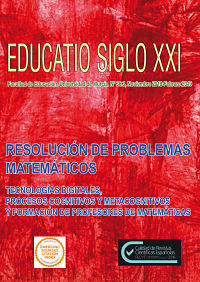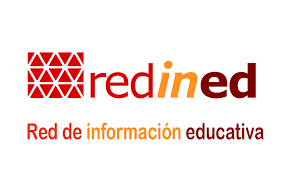Problem solving and regulation in learning
Abstract
Problem solving classroom practices have multiple facets. One of them is related to the evaluation and, consequently, the use of evaluation devices that enhance students’ learning as they help the students to reflect on their own outcomes. In this article we analyse the use of an orientation basis as a device to support first year secondary students’ mathematical problem solving. In particular, we study the relation between the number of actions of the orientation basis in which the students were involved when they solved a problem and their solutions to the problem. The emerging existence of this relationship allows us to consider the orientation basis as a problem-solving-related form of selfscaffolding.
Downloads
-
Abstract1865
-
PDF (Español (España))2337
References
Blanco, A. (2008). Las rúbricas un instrumento útil en la evaluación de competencias. En Prieto, L., Blanco, A., Morales, P. (Coords.) La enseñanza universitaria centrada en el aprendizaje: estrategias útiles para el profesorado. Barcelona, España: Octaedro Editorial.
Carrillo, J., y Guevara, F. (1996). Un instrumento para evaluar la resolución de proble- mas. UNO Revista de Didáctica de las Matemáticas, 8, 65-81.
Coltman, P., Petyaeva, D., y Anghileri, J. (2002). Scaffolding learning through meaningful tasks and adult interaction. EarlyYears, 22(1), 39–49.
De Corte, E., Verschaffel, L., y Op’tEynde, P. (2000). Self-regulation: A characteristic and a goal of mathematics learning. En M. Boekaerts, P. R. Pintrich y M. Zeidner (Eds.), Handbook of self-regulation (pp. 687–726). San Diego: Academic Press.
De Corte, E., y Verschaffel, L. (2003). El desarrollo de habilidades de autoregulación en la solución de problemas matemáticos. Pensamiento Educativo, 32, 286-305.
Departament d’Ensenyament. Generalitat de Catalunya. (2016). Un currículum compe- tencial per a l’educació primària. Un pas més cap a l’assoliment de les competències bàsiques. Recuperado de http://ateneu.xtec.cat/wikiform/wikiexport/_media/cursos/ curriculum/inf_pri/cape/info_prima_ria_29_6.pdf [enero 2018].
Kirkman, T.W. (1996) Exact r×c Contingency Table: How many rows? columns? Statis- tics to Use. Recuperado de http://www.physics.csbsju.edu/stats/exact_NROW_NCO- LUMN_form.html [enero 2018].
Jorba, J., y Sanmartí, N. (2004). La función pedagógica de la evaluación. En A. Parcerisa,
L. Rovira (Eds.) Evaluación como ayuda al aprendizaje (pp. 21-44). Barcelona, Es- paña: GRAÓ
Lester Jr., F.K., y Cai, J. (2016). Can Mathematica lProblem Solving Be Taught? Prelimi- nary Answers from 30 Years of Research. En P. Felmer, E. Pehkonen, y J.Kilpatrick (Eds.), Posing and solving mathematical problems. Advances and New Perspectives (pp. 117-135).Switzerland: Springer
Lester, F. K., y Kroll, D. L. (1991). Evaluation: A new vision. The Mathematics Teacher, 84(4), 276-284.
Llopis, J. (2013). Test exacto de Fisher. La estadística: una orquestra hecha instrumen- to. Recuperdo de https://estadisticaorquestainstrumento.wordpress.com/2013/01/21/ test-exacto-de-fisher/ [mayo 2017].
Mason, J. (2016a). Part 1 Reaction: ProblemPosing and Solving Today En P. Felmer, E. Pe- hkonen, y J. Kilpatrick, J. (Eds.), Posing and solving mathematical problems. Advances and New Perspectives (pp. 109-113). Switzerland: Springer
Mason, J. (2016b). When Is a Problem…? “When” Is Actually the Problem! En P. Felmer, E. Pehkonen, y J. Kilpatrick, J. (Eds.), Posing and solving mathematical problems. Ad- vances and New Perspectives (pp. 263-285).Switzerland: Springer
Mason, J., Burton, L., y Stacey, K. (1982). Thinking mathematically. Wokingham: Addi- son-Wesley.
Niss, M., y Højgaard, T. (Eds.) (2011). Competencies and Mathematical Learning. Ideas and inspiration for the development of mathematics teaching and learning in Den- mark, IMFUFA tekst 485/2011. Roskilde, Denmark: Department of Science, Systems and Models, Roskilde University.
Panaoura, A. (2016). Self-Regulatory Strategies During Problem-Solving by Using an In- quiry-Based Approach: “Make Sense of Problems and Persevere in Solving Them” . In
K. Newton (Ed.), Problem- Solving: strategies, challenges andoutcomes (pp. 197-210). Nova science publishers
Páramo, P., y Hederich. C. (2014). Educación basada en la evidencia. Revista Colombia- na de Educación, 66, 13-16.
Pólya, G. (1945). How to solve it. Princeton: Princeton University Press.
Ponte, J. P. (2007). Investigations and explorations in the mathematics classroom. ZDM Mathematics Education, 39, 419-430.
Rosli, R.,Goldsby, D.yCapraro, M.M. (2013). Assessing Students’ Mathematical Problem- Solvingand Problem-Posing Skills. Asian Social Science, 9(16),54–60.
Sanmartí, N., y Jorba, J. (1995). Autorregulación de los procesos de aprendizaje y cons- trucción de conocimientos. ALAMBIQUE Didáctica de las Ciencias Experimentales, 4, 59-77.
Sanmartí, N. (2007). Evaluar para aprender. 10 ideas clave. Barcelona, España: Graó.
Sanmartí, N. (2010). Avaluar per aprendre. L’avaluació per millorar els aprenentatges de l’alumnat en el marc del currículum per competències. Recuperado de http://xtec. gencat.cat/web/.content/alfresco/d/d/workspace/SpacesStore/0024/fc53024f-626e- 423b-877a-932148c56075/avaluar_per_aprendre.pdf [enero 2018].
Schoenfeld, A. H. (1992). Learning to think mathematically: Problem solving, metacogni- tion, and sense-making in mathematics. En D. Grouws (Ed.), Handbook for Research on Mathematics Teaching and Learning (334-370). New York: MacMillan.
Schoenfeld, A. H. (2013). Reflections on problem solving: theory and practice. The Mathematics Enthusiast, 10(1y2), 9−34.
Smit, R., Bachmann, P., Blum, V., Birri, T., y Hess, K. (2017). Effects of a rubric for mathe- matical reasoning on teaching and learning in primary school. Instructional Science, 45, 603–622.
Stacey, K. (2016). Reaction: Teachers, ProblemPosing and Problem-Solving En P. Felmer,
E. Pehkonen, y J. Kilpatrick, J. (Eds.), Posing and solving mathematical problems. Ad- vances and New Perspectives (pp. 387-391). Switzerland: Springer
Van de Pol, J., Volman, M., y Beishuizen, J. (2010). Scaffolding in teacher–student inte- raction: A decade of research. Educational Psychology Review, 22(3), 271–296.
Villalonga Pons, J. (2017). La competencia matemática. Caracterización de actividades de aprendizaje y de evaluación en la resolución de problemas en la enseñanza obli- gatória. Tesis doctoral. Universitat Autònoma de Barcelona.
Villalonga Pons, J.,y Andrews, P. (2017). Self-scaffolding students’ problem solving: Testing an orientation basis. En T. Dooley y G. Gueudet (Eds.), Proceedings of theTenth Congress of the European Society for Research in Mathematics Education. Dublin, Ireland: DCU Institute of Education and ERME.
Villalonga Pons, J. y Andrews, P. (2018). Supporting students’ mathematical problem solving: The key role of different forms of checking as part of a self-scaffolding mecha- nism. En E. Norén, H. Palmér y A. Cooke, Nordic Research in Mathematics Education: Papers of NORMA 17. The Eighth Nordic Conference on Mathematics Education Stockholm, May 30 - June 2, 2017 (pp. 79-88). Estocolmo.
Villalonga Pons, J. y Deulofeu, J. (2015). La base de orientación, una herramienta para ayudar al alumnado a resolver problemas. En FESPM y SEMRM (Eds.) Actas JAEM 2015: 17 Jornadas para el Aprendizaje y la Enseñanza de las Matemáticas (p. 36, 16 páginas). Cartagena, España.
Villalonga Pons, J.,y Deulofeu, J. (2017a). Representar problemas usando una base de orientación. UNO. Revista de Didáctica de las Matemáticas, 75, 59–65.
Villalonga Pons, J., y Deulofeu, J. (2017b). La Base de Orientación en la Resolución de Problemas: “cuando me Bloqueo o me Equivoco”. Journal of Research in Mathema- tics Education, REDIMAT, 6(3), 256–282.
Wood, D., Bruner, J., y Ross, S. (1976). The role of tutoring in problem solving. Journal of Child Psychology and Psychiatry, 17, 89–100.
Zimmerman, B. J. (1995). Self-Regulation Involves More Than Metacognition: A Social Cognitive Perspective. Educational Psychologist,30(4), 217–221.
Original work publishes in this journal is subject to the following terms:
1. Murcia University Press (the publishing house) holds the copyright of the publishes work, and favours and allows their reutilization under the use license stated in point 2.
© Servicio de Publicaciones, Universidad de Murcia, 2015
2. Work is published in the electronic edition under a license (Creative Commons Reconocimiento-NoComercial-SinObraDerivada 4.0 España (legal text). They can be copied, used, disseminated, transmitted and publicly presented, as long as: i) authorship and original publication source is acknowledged (journal, publishing house and URL of the work); ii) are not used for commercial purposes; iii) the existence and specifications of this use license is stated.
3. Conditions for self-archive. Authors are allowed and encouraged to disseminate electronically the pre-pint (before review) and/or post-print (accepted for publication) versions of their work before their publication since that favours earlier circulation and dissemination resulting in an increased chance for the authors to be cited and for the work to reach a bigger share of the academic community. Colour: RoMEO: green.








